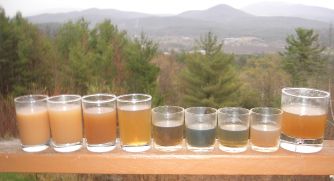This past weekend I was walking in the forest and realized that in the spring, the plump acorns on the ground were beginning to burst their shells (no squirrels in that part of the woods). I filled up my hat with acorns and easily shelled them on the remainder of our walk. Back at Mountain Man's home, I set to simmering them.
Here is the part that may interest you fiber fiends. The acorns simmered for probably twelve hours total, through nine changes of water. And every time the water came out a different shade, from milky, light brown to clear, steely grey. Seen below in order of boiling - first on the left, last on the right. What's going on here? Do different chemicals leach out at different times?

I was so terribly tempted to try dying some yarn in each cup, but possessed neither the time nor the ability (sometime I'll post about my last failed dying experiment, with foraged cochinealle bugs in Peru!).
Foodwise, the acorns were definitely less bitter, almost palatable even, after all that boiling. I plan on smashing them up and making pancakes with them.

No comments:
Post a Comment